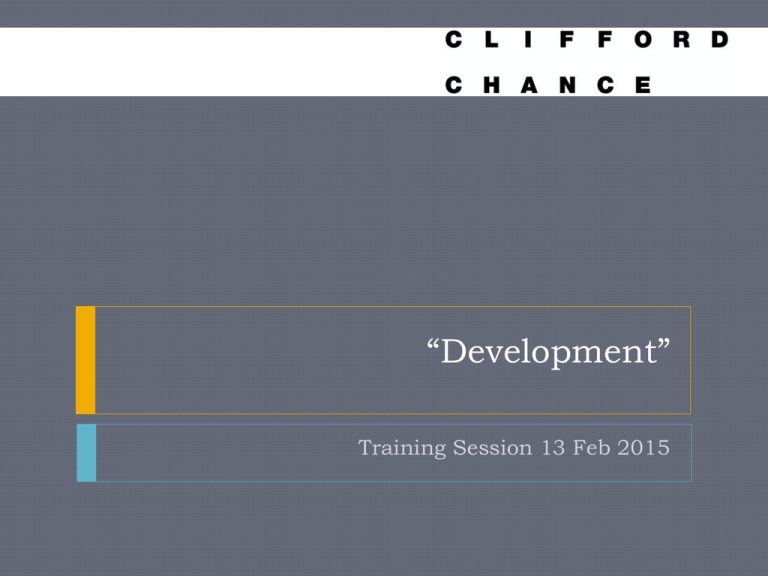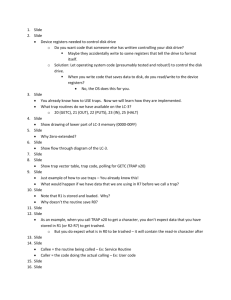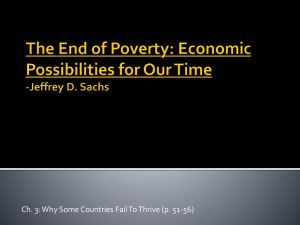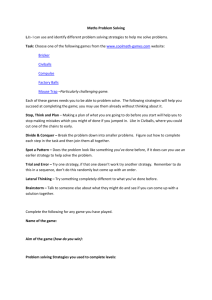Comparative Analysis - Warwick Debating Society
advertisement

“Development” Training Session 13 Feb 2015 What is the developing world? • For many years the term “developing world” has been used as a catch all term for everything outside the liberal west (e.g. about 5 billion people) • No longer really a useful grouping given the vast differences between China and Sudan, for example. • Lots of the traditionally developing world are growing at quicker rates than developed countries and are moving steadily towards (or have already achieved) middle income status (think China, India and Botswana) • The rest of the developing world is stagnant or growing backwards economically (think Sudan, the Central African Republic and Haiti) A brief snapshot of affairs in the bottom billion • Almost half of the world love on less than $2.50 US a day • The poorest 40% of the world’s population accounts for 5% of global income • 1.1 billion people have inadequate access to clean water • Half of the worlds children (1 billion of 2.2 billion) live in poverty • 1.6 billion people live without electricity • Nearly a billion people remain unable to sign their name In this training session… 1. Explanations for the economic failure of the bottom billion (based on Paul Collier’s ‘The Bottom Billion’) – – – – The Conflict Trap The Natural Resource Trap The Landlocked with Bad Neighbours Trap The Bad Governance in Small Countries Trap 2. Discussion of the potential solutions to these traps and the best development models (based on Collier, Dambisa Moyo, Sachs etc.) THE CONFLICT TRAP 73% of people in the bottom billion have recently been through a civil war or are currently in one. The Conflict Trap • There is an increased likelihood of conflict in the bottom billion – The three factors that most influence the likelihood of civil war are the starting income of a country, the growth rate of a country and its degree of reliance of natural resource exports – To quantify the impact • If you are to halve the starting income of a country you will double the risk of civil war • For each % point you add to the growth rate of a country you will knock the equivalent % off the risk of conflict The Conflict Trap • A low income combined with low growth rates amount to poverty and hopelessness in a population. – A lack of hope for a better future typically affects young uneducated males most, which also happens to be the main target for rebel group recruits • Low income and low growth contribute to a weak state – A weak state is easier to attack and therefore makes rebel movements and coups more likely to both be launched and to be successful The Conflict Trap • Dependence on natural resources also contributes to the likelihood of conflict – In the fist instance natural resources are the easiest way to finance a rebellion (Kabila in the Congo, rebels in Nigeria and Sierra Leone) – Moreover huge natural resource incomes increase the pay off of control The Conflict Trap • Some counterintuitive facts to keep in mind – Ethnic divides: some of the most ethnically diverse countries are the most peaceful, and countries with ethnic purity (Somalia) are conflict ridden. – Social and Political rights: often assume in West that rebellion happens over lack of democracy. Civil war just as likely in democratic poor countries as autocratic poor countries. – Geography: does have an effect (mountains more likely to have rebellion), still less important than the economic reasons. The Conflict Trap • Further weakens the economic situation in a country (Collier estimates that a civil war has on average a cost of $64 billion to the country and it’s neighbours) • Most of the costs occur in the aftermath of fighting (disease and displacement) • 90% of all countries with civil wars have recommenced conflict in the first decade following the war • Creates a legacy of killing which both makes people more inclined to violence and also creates resentment. THE NATURAL RESOURCE TRAP 29% of the bottom billion live in countries whose economies are dominated by natural resource exports The Natural Resource Trap • As previously stated, natural resources contribute to the conflict trap, however they are also a trap in and of themselves – even in peace time countries with natural resources are unlikely to grow. • The phenomenon is most often explained by “Dutch Disease” – Huge natural resource exports drive up the value of a country’s currency and in doing so make all other exports uncompetitive. – For example, in the 70’s oil boom the oil revenue coming into Nigeria sky rocketed and as a result all other exports (Cocoa and Peanuts) became uncompetitive. The Natural Resource Trap • Another aspect of this is the “Boom and Bust” nature of commodity exports – There is significant instability in the global price of commodities and as the price changes so does the entire income of the Government – More often than not this money is managed poorly by bottom billion governments – During periods of boom credit markets flow freely allowing governments to borrow huge amounts (inevitably the commodity reserves dry up and they are left with huge debt servings) – Electorates find it difficult to hold governments accountable The Natural Resource Trap • Commodity export reliance reduces the likelihood of democracy • Also reduces the functionality of democracy – The politics of patronage is commonplace throughout the bottom billion democracies and so increases in government cash flows serves to further entrench and extend patronage. • Where 20% of government income is resource based, electoral competition actually lowers the rate of growth by 3% as compared to autocracy. The Natural Resource Trap • Reduces likelihood if diversifying • Also increases the likelihood of conflict THE LANDLOCKED WITH BAD NEIGHBOURS TRAP Around 1/5 of the worlds countries are landlocked The Landlocked with Bad Neighbours Trap • Landlocked countries are reliant on their neighbours for both transport corridors to enable trade and as direct trade markets. • Collier suggest bleak prospects and that they will be reliant on aid forever. • Can’t un-landlock yourself • Many of these countries are also in conflict with their neighbours and have limited capacity to effect change in their economies THE BAD GOVERNANCE IN SMALL COUNTRIES TRAP The Bad Governance in Small Countries Trap • Having money is no good unless it is spent well – • Democracy does not increase the likelihood of good governance ( think of the patronage politics previously discussed) – • • In 2004 a study tracked money released by the Ministry if Finance in Chad and found that only 1% of it actually reached its destination What does increase the likelihood id having a large population, having a high proportion of secondary educated people The cost of failing states (to itself and its neighbours) is around $100 billion Poor governance is a trap – As corrupt officials take hold all the good people leave and there is little push for change AID Over the past 30 years it has added around 1% point to the growth rate of the bottom billion. What is aid? • It can either be a grant (European Commission) or a loan (IMF) • It can be given to governments or to individual communities (microfinance). • It can be given to governments as either budget support (general cash injection) or earmarked for a particular project. • It can be distributed through NGOs, government departments or international institutions. • It can be given conditions ex ante (a government promising to institute changes following the aid) or ex post (a government that already has stronger policies). Aid • Until now, at best aid has prevented total collapse of many countries, rather than promoted growth. • At the Gleneagles G8 summit in 2005 there was an agreement to double aid. • Aid is subject to ‘diminishing returns’. • We already know huge budget support is unlikely to work – Nigeria oil Aid • The implication is the same for debt relief • Aid is notably more successful in countries with good governance, which is fairly controversial as they are perceived to be the least in need. • Relationship to military spending – 11% of aid is spent on military – In Africa 40% of all military spending is financed by aid • Politicisation – Don’t give to worst off – your job is tied to doing well – World Bank Aid • Conflict Trap – Some argue that it increases the pay off and induces rebellion (Collier’s research does not support this but he acknowledges anecdotal evidence) – Coups on the other hand are more likely in heavy aid environments – On the other hand, if it works effectively it can increase income and kick start growth (which are important factors in the likelihood of conflict) – Aid is particularly effective in post conflict context Aid • Natural Resource Trap – Aid is useless (these places have enough money it us just misused) Aid • Landlocked – Need to be on aid for a long time – Need to be used to improve costal links and bigger neighbouring markets (rather than organised country by country) Aid • Bad Governance – As an incentive? – As skills? • Instituting good policies for you – As reinforcement? – Prior to reform? Aid • Many economists are very anti aid – Former IMF Chief Economist Raghuram Rajan argues that it retards growth in the labour intensive export markets – Dambisa Moyo “Dead Aid” (Closes out private investment) – William Easterly “The White Man’s Burden” (Aid is the new colonisation) TRADE Trade • Rich countries must reduce protectionism – There is a serious issue with policy incoherence in the western world: we continue to give large amounts of money in aid that is then undermined by our refusal to make any changes to trade policy – We can take the hit, there are alternatives to cotton for American farmers, where there are not for cotton farmers in Chad. Trade • Bottom billion countries must reduce protectionism – Focusing on domestic markets is a non-starter – there is insufficient local demand or money to create industry and jobs – Provide a cover for government corruption Trade • Bottom billion countries must reduce protectionism – Focusing on domestic markets is a non-starter – there is insufficient local demand or money to create industry and jobs – Provides a cover for government corruption Trade • Aid worsens trade barriers and therefore is best when accompanied by trade liberalisation. – – – – – – – If a government wants to spend aid on schools and hospitals they have to sell the foreign exchange to get local currency to spend. People buy foreign exchange to pay for imports. Aid is valuable only to the extent that people want to buy imports If imports have incredibly high tariffs then the demand for foreign exchange is low and you can’t really build schools and hospitals. Other than through aid, foreign exchange is generated through exports – in that way exports and aid are in competition (for foreign exchange) As such more aid means less need for exports and can make exports less profitable Trade liberalisation increases the demand for imports (as they are now cheaper) and in doing so increases the demand for foreign exchange and balances out the effect of aid. Trade • Is ‘fair trade’ the solution? – The short answer is no. – At best it decreases export diversification as it locks producer into producing fair trade goods. • Is export diversification the solution? – First step to avoiding the natural resource trap and avoiding boom and bust cycles. – In order to create a functioning export market in manufacturing and agriculture, the bottom billion must be protected from competition in Asia Trade • Should the bottom billion leave the WTO? – The WTO is premised on negotiating beneficial trade liberalisation – Unfortunately Africa has very little to offer the Western World and as such it has mostly been the loser in WTO negotiations








